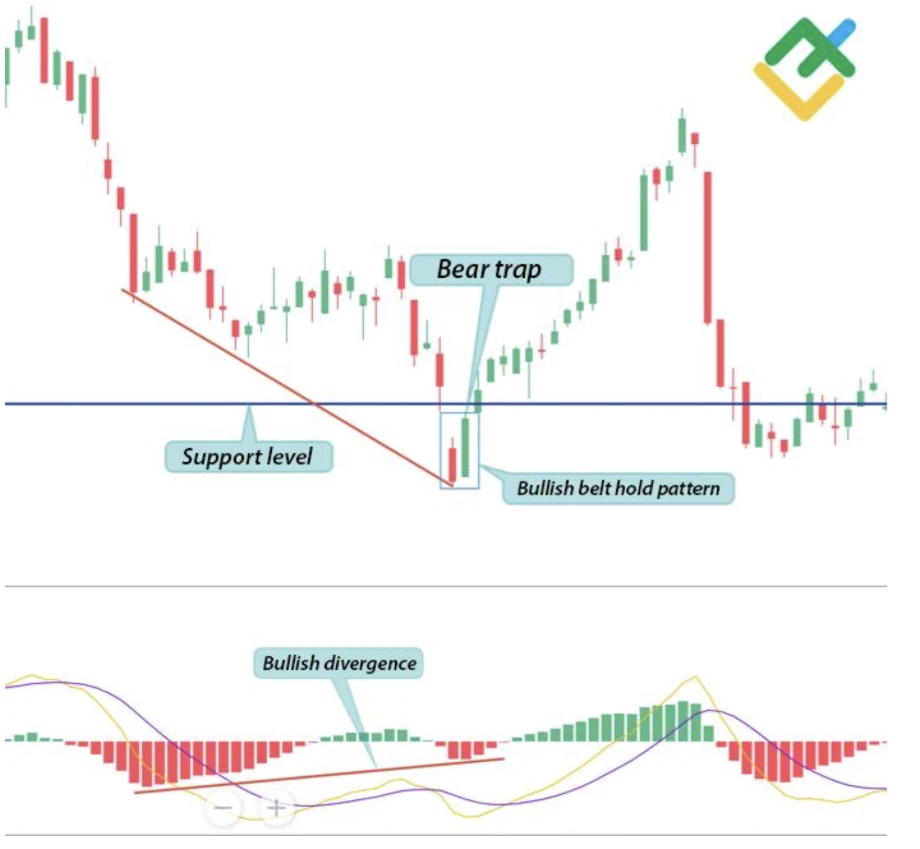A bear trap is a deceptive market move that can lead to stop-loss triggers, forced liquidations, and short squeezes, causing losses for those who enter shorts prematurely. Falling for bear traps can erode capital and disrupt trading strategies.
Take a look at how traders can identify and avoid reverse bear traps while trading forex.
What is a reverse bear trap?
A reverse bear trap is a false bearish breakdown that tricks traders into exiting the trade before a sudden price reversal. It occurs when the price drops below a key support level. This often triggers stop-losses and short-selling.
However, instead of continuing downward, the price quickly rebounds above support. This forces short sellers to cover their positions, driving prices higher. The pattern traps bearish traders and creates a sharp upward move. Smart traders wait for confirmation before acting to avoid being misled.

How to identify a reverse bear trap?
- Identify a strong support level: Find a well-established support level where the price previously bounced. Strong support increases the likelihood of a bear trap.
- Watch for a breakdown below support: Price temporarily falls below support, triggering stop-losses and short positions. This move appears to confirm a bearish breakdown.
- Look for a quick price rebound: Instead of continuing lower, the price quickly moves back above support, signaling that bears may be trapped.
- Confirm with indicators: Use RSI, volume spikes, or bullish candlestick patterns to confirm a reversal. Oversold conditions strengthen the bear trap signal.
- Enter a trade and manage risk: Once confirmation is clear, enter a long position. Set a stop-loss below recent lows and set a take-profit at key resistance levels.
Why to avoid a reverse bear trap?
High risk of short squeezes
Traders shorting the breakdown get trapped when the price rebounds. Covering their positions fuels a sharp upward move, leading to significant losses. A strong rally can force traders to exit at unfavorable prices and vice versa.
Creates false breakdown signals
The price drop below support looks like a real breakdown. However, it reverses quickly, misleading traders into taking bearish positions. This can cause unnecessary losses for those relying on technical breakdowns.
Can trigger forced liquidations
Stop-loss orders on short positions get hit as price surges. This forces liquidations, amplifying the reversal and increasing volatility. Highly leveraged positions are especially vulnerable to sudden price spikes.
Lacks strong downside follow-through
Unlike true breakdowns, a bear trap fails to sustain exit pressure. The price recovers, proving the bearish move was deceptive. Weak momentum suggests that bears lack conviction, reducing the likelihood of further declines.
Often results in whipsaw movements
Rapid reversals cause unpredictable price swings. Traders entering shorts prematurely face choppy action, making risk management difficult. This volatility can lead to repeated stop-loss hits, frustrating traders.
Stepwise guide: how to avoid a reverse bear trap
Confirm the breakdown with volume
A true breakdown should be supported by high exit volume. It could be a bear trap if the price drops below support with low volume. Strong volume shows conviction from bears, while weak volume suggests a lack of real exit pressure, increasing the risk of reversal.
Look for multiple closes below support
A single close below support can be deceptive. To confirm a breakdown, wait for at least two to three consecutive closes below support on a significant timeframe like the 1-hour or daily chart. This prevents acting on false signals and ensures the breakdown has real momentum.
Check for RSI and MACD confirmation
Use indicators like RSI and MACD to validate the breakdown. An RSI below 40 signals strong bearish momentum, while MACD should show a bearish crossover. If the RSI stays above 40 or the MACD lacks a crossover, the move might be a trap, indicating a potential price recovery.
Watch for a retest of the broken support
After breaking support, the price often retests the level before continuing downward. A failed retest, where the price reclaims support, signals a bear trap. If the breakdown is real, the retest should result in rejection with strong exit pressure, confirming further downside movement.
Use stop-loss above the breakdown level
Protect the trade by placing a stop-loss slightly above the broken support. This prevents large losses if the price reverses. A well-placed stop-loss ensures that traders can exit quickly if a bear trap occurs before getting caught in a short squeeze or sharp recovery.
Wait for a clear downtrend before shorting
A confirmed downtrend increases the likelihood of a proper short trade. Look for lower highs and lower lows before entering. Avoid shorting right after a breakdown without confirmation, as premature entries often lead to losses if the bear trap triggers a sudden price reversal.
Example of a bear trap
For example, let’s assume that a hypothetical currency pair ABC/XYZ is trading at 1.1000, with strong support at 1.0980. Many traders watch this level, expecting a breakdown if the price movement is lower.
Then, the pair drops to 1.0970, breaking below support. This move convinces traders that further decline is coming, prompting them to take short positions. However, instead of continuing downward, ABC/XYZ quickly rebounds above 1.0980.
As the price rises back above support, short-sellers rush to exit their positions, purchasing back the currency to cover their trades. This creates a short squeeze, pushing ABC/XYZ higher, eventually reaching 1.1020.
Traders who shorted prematurely suffer losses, while those who waited for confirmation avoid the trap.
Steer clear of bear traps
Avoiding bear traps in forex trading prevents unnecessary losses and improves trade accuracy. False breakdowns lure traders into short positions before sudden reversals, leading to stop-loss hits and short squeezes.
To avoid them, confirm breakouts with volume, RSI, MACD, and multiple closes below support. Also, always wait for a retest before shorting. By avoiding bear traps, traders reduce risk, improve trade timing, and increase overall gains in the financial market.
Disclaimer: All material published on our website is intended for informational purposes only and should not be considered personal advice or recommendation. As margin FX/CFDs are highly leveraged products, your gains and losses are magnified, and you could lose substantially more than your initial deposit. Investing in margin FX/CFDs does not give you any entitlements or rights to the underlying assets (e.g. the right to receive dividend payments). CFDs carry a high risk of investment loss.




